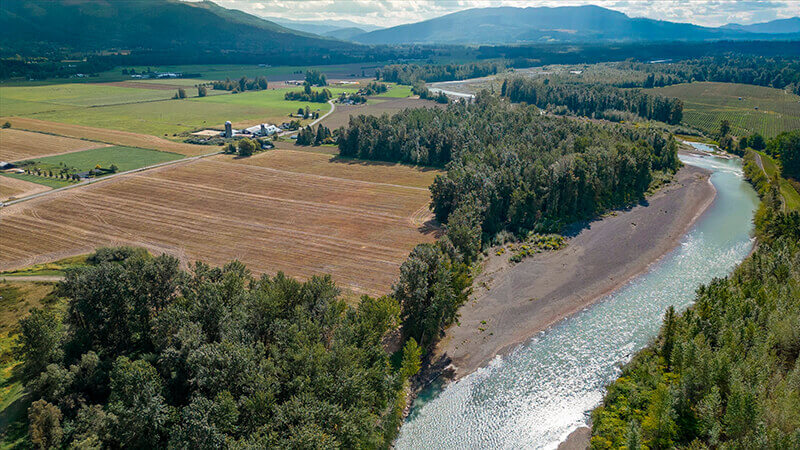How to Protect Your Water Rights
In April 2024, a critical event is set to unfold that will have a significant impact on water users in the Nooksack River watershed in Whatcom County, Washington. The event in question is the long-awaited adjudication, a legal proceeding before a Whatcom County Superior Court judge that aims to assess the validity of claims to use water for various purposes, from fish habitat to domestic and agricultural use. This article will delve into the intricacies of the adjudication process, why it matters, and what you can do to safeguard your water rights.
Understanding the Adjudication Process
The adjudication process is essentially a judicial evaluation of water claims within the Nooksack River watershed. This encompasses various uses such as domestic (indoor and limited outdoor) use, livestock watering, and irrigation. Here’s a breakdown of the key phases:
- Filing of Lawsuit: The adjudication process begins with the filing of a lawsuit, expected in April 2024. Claimants, or parties with water rights, will receive a summons notifying them of the lawsuit’s commencement and how to participate.
- One-Year Filing Period: Following the summons, there will be a one-year window for claimants to file their claims. Ignoring this proceeding could result in the loss of your water rights, and your priority date will be pushed to the lowest on the list.
- Three-Year Evidentiary Period: After the filing period concludes, a three-year evidentiary phase begins. During this time, claimants are required to gather evidence of their water usage to substantiate their claims.
- Department of Ecology Review: Subsequently, the Department of Ecology will review each claim and its accompanying evidence. Contested claims may require court appearances to defend the submitted evidence.
- Judicial Decision: Once all claims and objections have been evaluated, the judge will issue an adjudication order. This document will detail the claims filed, prioritize them by date, and specify the permitted water usage for each claim.
The Importance of Gathering Evidence
To strengthen your water rights claims, it’s imperative to start gathering evidence now. Here’s how you can ensure your claim stands strong:
- Document Water Usage: Keep records of your water usage. If you have an irrigation system, check driplines, use crop water estimates, and utilize satellite or aerial imagery to monitor crop conditions. Consider hiring consultants for accurate calculations and reports.
- Review Existing Rights: Search for well logs, water rights certificates, or deeds associated with your property. The Department of Ecology’s Water Explorer page can also be a valuable resource.
- Consult Experts: Don’t hesitate to seek assistance from water consultants or legal counsel to ensure your claim aligns with your actual water usage.
Irrigation Water Rights
One aspect of the adjudication process pertains to irrigation rights such as:
- Changing Water Usage: Ecology contends that some areas in the Nooksack watershed have water being used for irrigation without proper documentation. Ensure your water rights match your land and usage.
- Specific Information: Irrigation rights are parcel-specific and require details about the point of withdrawal, total water amount (in acre-feet), and instantaneous water quantity (in CFS or GPM).
- Matching Information: If your water usage information doesn’t match your land, consult a water consultant or legal counsel to correct this discrepancy.
Involvement of Water Associations
Water associations and water districts also have a role in the process.
- Association Responsibility: The association manager should be responsible for gathering the necessary information to support the claim.
- Municipal Water: For those with municipal water, the city and its attorney will handle the claim, so individual homeowners need not be concerned.
Understanding Permit Exempt Wells
The adjudication process extends to permit exempt wells, which are an essential source of groundwater. Here are some key points to consider:
- Usage Prior to 2016: Prior to October 6, 2016, permit exempt wells could withdraw up to 5,000 gallons/day for domestic use, outdoor irrigation for half an acre of non-commercial lawn or garden, and other permitted uses.
- 2016-2018 Moratorium: Between October 6, 2016, and January 18, 2018, there was a moratorium on building permits relying on permit exempt wells. It was lifted in December 2016 under specific conditions.
- 2018 Onward: After January 18, 2018, limits on permit exempt wells were further reduced, with restrictions on domestic use and irrigation.
Protecting Your Water Rights
Remember that water rights are “use it or lose it.” Continuous beneficial use is crucial to maintaining your rights. If you encounter periods of non-use, consider seeking legal counsel or a water consultant to explore options like placing your water rights in a trust to prevent relinquishment.
The impending adjudication in the Nooksack River watershed is a pivotal event for water users, including those with groundwater rights. It’s essential to be proactive in gathering evidence, ensuring your claims align with your actual water usage, and staying informed about the evolving regulations. By taking these steps, you can protect your valuable water rights and maintain a secure water source for years to come. Don’t wait. Act now to secure your place in the Nooksack River watershed’s water future.
Special thanks to Perry Eskridge for help with this article.
See this article in the January 2024 online edition:
January 2024

Allison and Blake earned The Institute for Luxury Home Marketing’s Million Dollar GUILD™ recognition for experience, knowledge, and expertise in million-dollar and above residential properties. Allison and Blake are Certified Luxury Home Marketing Specialists™ (CLHMS), an exclusive group of real estate professionals who have completed The Institute’s training and have a proven performance in the upper-tier market. We both have extensive experience as equestrian professionals which gives us a unique set of skills and experiences that benefit both Buyers and Sellers. Let us help you make your equestrian dream a reality.
E: [email protected] | C: 360-961-5537 | W: www.allisonblakerealestate.com




